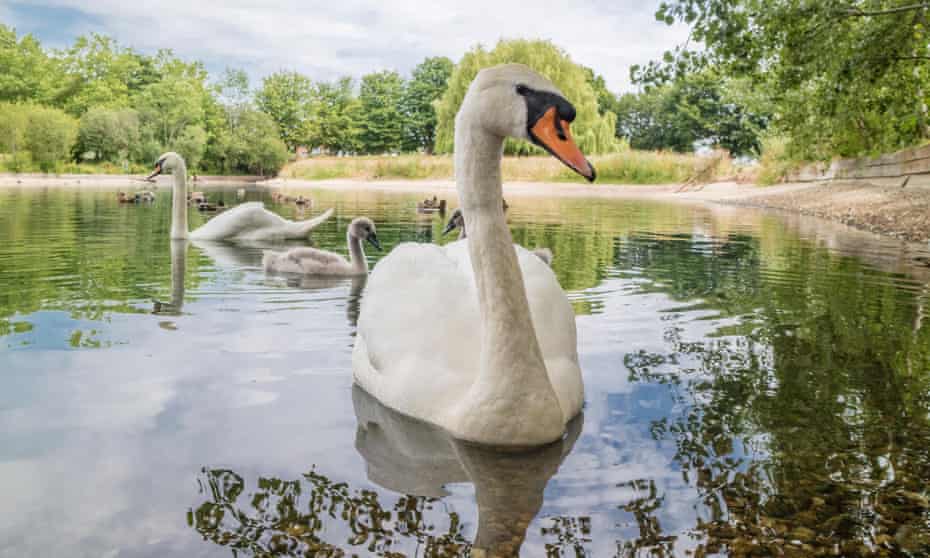Britain loves swans. So why do we cause them untold harm?
These elegant birds have long held a special place in the nation’s heart and imagination. But now they are dying in untold numbers

Last modified on Sat 6 Nov 2021 11.29 EDT
To the British, the swan is not so much a bird as a national treasure – the avian equivalent of Dame Judi Dench or Sir David Attenborough. Its unique status is a result of its long and complex history living alongside us, a relationship that goes back well over a thousand years.
Alarm at reports last week that dozens of swans and cygnets have died of bird flu in Shakespeare’s home town of Stratford-upon-Avon – up to half of the town’s population – reminded us just how passionate the British public are about the bird.
Swans are both more vulnerable than many other birds to the disease, and being so large and obvious, when they do have symptoms more likely to get noticed. The town’s former mayor, Cyril Bennis, who has been campaigning on behalf of the local swans for four decades, has described the deaths as “heartbreaking”.
The swans in Stratford – and the species we usually see on our park ponds, lakes, rivers and gravel pits – are mute swans; yet despite this name, they can and do make a wide range of sounds. “Mute” was chosen to contrast with the whooper swan which, as its name suggests, makes a loud, honking call when in flight.
What is not so well known is that the mute swan used to be called the “tame swan”. This was partly to distinguish it from the two species of “wild swan” – the whooper and its smaller cousin, the Bewick’s – both of which are winter visitors to Britain from Iceland, Scandinavia and Siberia. The description “tame” was applied because, for more than a millennium from the Anglo-Saxon era through to the 19th century, swans were farmed in swanneries. Today, only one of these, at Abbotsbury in Dorset, survives.

Swans were kept not simply as a source of feathers and meat (the tender cygnets being preferred to the adults’ much tougher, gamier flesh), but also as a status symbol; owning them was in the gift of the monarch, who would bestow on favoured nobles the right to keep swans. Such was the value of these magnificent birds that to kill a swan was classed as treason, and taking even a single egg could result in a year’s imprisonment.
The fact that swans were in the gift of the crown led to another myth – that all Britain’s swans are owned by the Queen. They are not; although the annual swan-upping ceremony on the River Thames, in which the year’s new cygnets are caught and marked, does denote royal ownership of some.

Unlike most birds, swans are indeed very tame. Sometimes they may approach closer than you would prefer, especially if you are on their territory in the breeding season. And although the belief that a swan can break a man’s arm with a single blow of its wing is another myth, when a large male shuffles towards you with wings outstretched, hissing loudly, it can be pretty scary. As the Queen’s official swan warden, Professor Christopher Perrins, points out, not everybody likes swans.
Not surprisingly for such a huge and noticeable bird, swans feature more than almost any other species in myths and legends, art and literature, across much of the northern hemisphere.
Ancient swan myths include Leda and the Swan. This dates back to ancient Greece, when the all-powerful god Zeus supposedly turned himself into a swan so that he could approach – and then seduce – Leda, Queen of Sparta. This story has featured prominently in art, poems and music by, among others, Michelangelo, Leonardo da Vinci, WB Yeats and Lou Reed, all of whom were seemingly captivated by the taboo subject of sex between a swan and a woman.
Perhaps the most celebrated depiction of swans is in Tchaikovsky’s stunning Swan Lake, the most performed, and possibly best-loved, ballet of all time. As well as the wonderful music, its popularity is surely also due to the visual beauty of the white swan at the heart of the story. A darker side to swans was explored in the 2010 film Black Swan, starring Natalie Portman, a tale of rivalry and madness, which swept the board at the following year’s Oscars.
Amid all this history, mythology and culture, it is easy to forget that the swan is a real bird which, despite its size, can also be extremely vulnerable. As well as suffering from bird flu, swans can die from attacks by dogs, plastic waste, discarded fishing tackle, collisions with pylons or wind turbines, and – a very current threat – waterways polluted with raw sewage.
At the end of the first lockdown in summer 2020, there was also a steep rise in the number of swans being deliberately killed with airguns and catapults – often leaving behind cygnets to starve to death. As a nation we may love swans, but we also cause them untold harm.
The Swan: A Biography, by Stephen Moss (Square Peg) is out now. He is a naturalist and author based in Somerset, who runs the MA nature and travel writing course at Bath Spa University